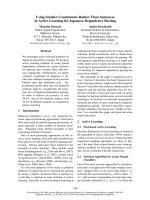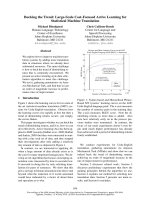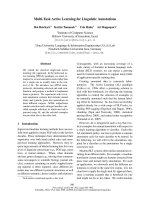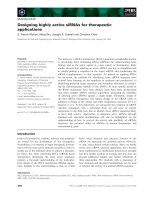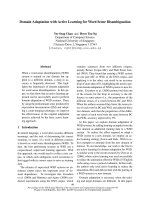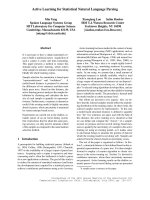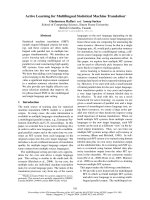Active Packaging for Beverages
Bạn đang xem bản rút gọn của tài liệu. Xem và tải ngay bản đầy đủ của tài liệu tại đây (3.81 MB, 13 trang )
10
Active Packaging
for Beverages
Paul L. Dawson
CONTENTS
Introduction
Food Labeling
Oxygen Scavengers/Antioxidants
Antimicrobial Polymers
Bio-Based Materials for Packaging
Taint Removers
Conclusion
References
INTRODUCTION
Active packaging can be deÞned as “packaging that performs a role other
than an inert barrier to the outside environment” (Rooney, 1995a). Some
crude examples of active packaging cited by Rooney (1995a) include wine
skins that collapse with removal of the wine to maintain a minimal headspace
in the package and tin-lined cans to prevent corrosion of iron in cans. The
traditional wine bottle has several “active” components including colored
glass, which prevents light damage; the cork, which is kept damp by storing
the bottle horizontally to improve the oxygen barrier; and the tin layer, which
prevents contact between lead and the wine.
More advanced types of active packaging, such as oxygen scavengers,
were produced as early as 1938 in Finland. Different active packaging types
have been produced in response to speciÞc needs of the product. “Smart”
Þlms have been used in horticulture products longer than in other products
to maintain an ideal gas atmosphere for slow respiration. These smart Þlms
now include oxygen scavengers to create a low oxygen environment, ethylene
scavengers to keep this plant-ripening hormone at low levels, and carbon
dioxide releasers that slow plant tissue respiration. Active packaging has also
been applied to other foods such as high a
w
bakery products, for which
TX110_book Page 205 Tuesday, May 6, 2003 9:21 AM
© 2003 by CRC Press LLC
ethanol-releasing sachets can be used to suppress mold growth. Microwave
susceptors actively heat and alter products for consumption; examples
include popcorn and portions of prepared meals.
A speciÞc active package type is not normally applied across a broad
spectrum of food products. Rather, it is applied to a speciÞc niche to extend
the quality or safety of that product. One such example of a speciÞc niche
is self-heating cans of sake. Aluminum cans are heated by the controlled
mixing of lime and water. Wagner (1989) reported that 30 million such cans
were produced in 1988. This process was also applied to coffee containers
and lunchboxes. Self-cooling cans have also been developed, using the
reaction between ammonium nitrate and chloride. A rather large niche is
oxygen-scavenging closures for beverages such as beer.
Brody (2001a), in reporting on international food packaging meetings,
differentiated between active and intelligent packaging, deÞning active pack-
aging as systems that sensed environmental changes and responded by chang-
ing properties. He further differentiated that intelligent packaging measures
a component and signals the result. Examples given of active packaging
include oxygen absorbers, antimicrobials, and controllers of moisture, odor
and gases. Intelligent packaging includes antitheft indicators, locating
devices, and time–temperature sensors. An example of a unique use of
time–temperature sensors is indicators on special containers of Hungry Jack
Pancake Syrup to indicate the optimum serving temperature during micro-
wave heating. The deÞnition of active packaging may be too narrow in that
it implies that an environmental change must occur for the package response
to occur. Antimicrobial and antioxidant packaging will release active com-
ponents to the food without an environmental change. Using a broader
deÞnition, active packaging acts on the food product to maintain quality or
change the food for consumption.
Most active packaging applications are used to maintain the quality of
the product. The quality factors that deteriorate most quickly in beverages
are related to oxidation and microbial growth. Oxidation can alter color,
ßavor, and nutritional value, while microbial growth can affect these factors
as well as safety. Since oxidation requires oxygen, a common method to
slow this reaction is exclusion and removal of oxygen from the package.
Oxygen scavengers or absorbers can be included in packaging systems as
sachets, as closures (crowns), and in polymers. Iron-based scavengers have
dominated the scavenger market; however, other systems have been intro-
duced that use ascorbic acid in combination with other organic and inorganic
compounds. Antimicrobial Þlms have not had the same widespread applica-
tion as oxygen scavengers in beverages. The most discussed antimicrobial
packages have been those containing silver ions or salts dispersed in zeolite.
These were Þrst introduced in Japan. Silver has been incorporated into
TX110_book Page 206 Tuesday, May 6, 2003 9:21 AM
© 2003 by CRC Press LLC
polymer coatings, which are used to coat metal surfaces, by Agion. These
products are marketed by AK Steel. The use of oxygen scavengers and
antimicrobials will be discussed in more detail in later sections of this
chapter. Other topics covered will include food labeling regulations, antiox-
idants, bio-based packaging and taint removers.
FOOD LABELING
Active packaging systems may sometimes require that a component
migrate from the package to the food. This has relevance to food package
labeling in that the food contact surface of a package must be proven to
be safe. That is, any compound that migrates from the package into or onto
the food is considered a food additive. Food additive requirements include
that the additive:
1. Must be safe at the intended use level
2. Must perform a function
3. Must not mask a property
4. Must not reduce nutritional value
5. Must not replace a Good Manufacturing Practice (GMP)
6. Must have a method for its analysis
Before approval, a compound classiÞed as a food additive must have its
safety established in experimental animal and/or human feeding trials. The
regulations for each additive must describe the approved applications,
amounts that are safe, and the conditions necessary to not harm the public.
Approved additives can be found in the Code of Federal Regulations (CFR),
Title 21, Parts 180–189. Some food additives fall into a category called
generally recognized as safe or GRAS substances. The GRAS substances
are exempt from food additive approval guidelines but still must be used
only in approved products, within approved levels, and according to GMPs.
All food additives, GRAS or not, must be listed on the food label. An effective
active package that requires migration or has incidental migration would
therefore need to have approval of the migrating compound as a food addi-
tive, and the label must declare that compound as a preservative.
OXYGEN SCAVENGERS/ANTIOXIDANTS
As stated in the introduction, the Þrst patent for an oxygen scavenger for
food was granted in 1938 for the removal of residual oxygen from the
headspace of cans. The development of oxygen scavengers has continued
with such advances as triggering the reaction by the presence of water,
TX110_book Page 207 Tuesday, May 6, 2003 9:21 AM
© 2003 by CRC Press LLC
placing the scavenger in a Þlm, and the development of non–iron based
systems. Rooney (1995b) reported that 60 worldwide patents had been
granted for oxygen scavenging sachets and 50 for oxygen scavenger–based
polymers. The potential applications for oxygen scavenger plastics were
summarized by Rooney (1995b) with the beverage applications including
aseptically packaged liquids, bag-in-box beverages, coffee, and pasteurized
drinks. For beverages, the use of oxygen scavengers in the sachet is not
normally practical, thus closures (crowns) and polymers have had wider use.
One problem facing packaging-based oxygen scavengers is stability with
exposure to air prior to use. For blow-molded beverage containers, this can
be overcome by combining the catalysts during the Þnal blow-molding step
closely followed by Þlling and sealing. The activating catalyst can also be
combined with the substrate during Þlling, as is done with the Ox-Bar system.
Other activating steps have also been developed such as exposure to water
or light.
Oxygen scavenging had early application in the preservation of beer.
Flavor quality was linked to oxygen content (Gray et al., 1948), leading the
American Society of Brewing Chemists to recommend the study of adding
antioxidants such as sulÞtes and ascorbic acid to retard ßavor loss. Reinke
et al. (1963) found that the use of cans lined with antioxidants improved
beer shelf life. The removal of oxygen from the bottle headspace after sealing
requires that a scavenger react with the gas without reacting with the bev-
erage. To accomplish this, scavengers are incorporated into the closure
(crown) by two methods. The Þrst method utilizes a sachet attached to the
inside of the closure with a membrane to separate the scavenger from the
beer. The membrane permits oxygen and water vapor to permeate the sachet
but prevents the scavenger from leaching into the beverage. The second
method has a scavenger incorporated into a polymer coating on the inside
of the closure. W.R. Grace developed a polymer liner for beer bottle caps
containing sodium sulfate and sodium ascorbate in 1989. Polyvinyl chloride
is often used as the carrier for the scavenger due to its high permeability to
oxygen and water vapor. An oxygen-scavenging closure has been evaluated
for use with several beer brands. The reaction rate of the ascorbate or
erythorbate (ascorbate isomer) salts can be increased by the addition of
transition metal salts. Copper and iron are the metals of choice, and this
principle was applied by Zapat A (formerly Aquanautics Corporation) to
produce Smartcap
‚
in 1991. Smartcap and the newer version, Pureseal
‚
, are
produced by Zapat A, which sold over 1 billion crowns in 1993. The crowns
were found to reduce oxygen levels in beer bottles after 1 to 3 months of
storage with the effects maintained through 9 to 12 months of storage
(Teumac, 1995). As of 1993, 20 microbreweries were believed to be using
Pureseal crown liners including Sierra Nevada Brewing Co., Cellis Brewing
TX110_book Page 208 Tuesday, May 6, 2003 9:21 AM
© 2003 by CRC Press LLC
Co., Abita Brewing Co., and Full Sail Brewing Co. (Sacharow, 1995). The
use of package oxygen scavengers for beer is gaining acceptance, allowing
for maintenance of quality during shipment to more distant locations from
the point of origin.
The use of scavengers for other beverages is being explored and is espe-
cially relevant for beverages containing natural colors and ßavors that are
susceptible to oxidation. Natural juices are susceptible to oxidation resulting
in the loss of color, texture, ßavor, and nutrients. Many beverages have been
introduced that contain natural components or that have added nutrients that
are oxygen labile. Some vitamins are very sensitive to oxidation, and the use
of oxygen scavengers for beverages making health claims and containing
oxygen-sensitive components may maintain nutritional quality.
The use of oxygen-scavenging sachets for beverages has been limited;
however, oxygen-scavenging sachets have been used with roasted coffee.
The Ageless E sachet (manufactured by Mitsubishi Gas Chemical Co.)
contains ascorbic acid and absorbs oxygen and carbon dioxide. While oxygen
is the main factor causing the deterioration of ground coffee, freshly ground
coffee also releases signiÞcant amounts of carbon dioxide. To allow pack-
aging of ground coffee almost immediately after grinding, sachets that absorb
carbon dioxide are often added. Soft packs or pillow packs of ground coffee
have been equipped with a one-way valve in the side of the package that
opens and releases carbon dioxide when the internal pressure reaches a preset
limit. This system facilitates the packaging of freshly ground coffee, mini-
mizing exposure to oxygen while allowing for the release of carbon dioxide.
The addition of antioxidants to packaging has been shown to be effective
in maintaining the quality of foods other than beverages. To prevent the
oxidation of meat pigments, butylated hydroxytoluene (BHT) and butylated
hydroxyanisole (BHA) were incorporated into polyethylene at the 0.1%
level; BHT was effective in color maintenance (Dawson, 2001; Finkle et al.,
2000). Both BHT and BHA migrated equally into ethanol (the standard Food
and Drug Administration [FDA] fatty food simulant), while only BHT
migrated into water. Table 10.1 shows the results of this experiment.
TABLE 10.1
Migration of BHA and BHT into Water and 95%
Ethanol (ppm, w/v)
Antioxidant Day 0 Day 3 Day 6 Day 9
BHA, water 0.83 4.03 9.62 18.45
BHT, water 0.00 0.00 0.00 0.00
BHA, 95% ethanol 1.22 19.51 26.13 25.32
BHT, 95% ethanol 0.00 0.00 0.00 0.00
TX110_book Page 209 Tuesday, May 6, 2003 9:21 AM
© 2003 by CRC Press LLC



